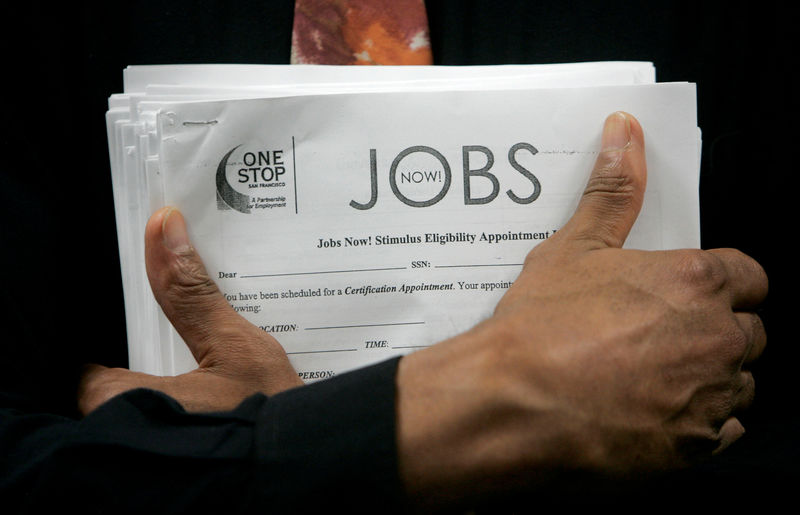By Lucia Mutikani
WASHINGTON (Reuters) - The number of Americans filing for unemployment benefits unexpectedly fell last week, suggesting that a strong economy was helping the labor market weather ongoing trade tensions between the United States and a host of other countries.
Other data on Thursday showed a solid increase in underlying producer prices in July. Labor market strength and rising inflation likely keep the Federal Reserve on track to raise interest rates in September for the third time this year.
"Trade war tensions in the clouds out there on the horizon may still move closer to shore later this year," said Chris Rupkey, chief economist at MUFG in New York.
Initial claims for state unemployment benefits slipped 6,000 to a seasonally adjusted 213,000 for the week ended Aug. 4, the Labor Department said. Data for the prior week was revised to show 1,000 more applications received than previously reported.
The claims data is being closely watched for signs of layoffs as a result of the Trump administration's protectionist trade policy, which has left the United States embroiled in tit-for-tat tariffs with major trade partners including China, Mexico, Canada and the European Union.
Washington imposed duties on steel and aluminum imports, provoking retaliation by the nation's trade partners. The United States has also slapped tariffs on Chinese goods, with Beijing responding in kind. Manufacturers are increasingly complaining about more expensive steel and aluminum raising production costs, as well as causing disruptions to the supply chain.
There have been reports of some companies either laying off workers or planning job cuts because of the import tariffs.
Claims dropped to 208,000 during the week ended July 14, which was the lowest reading since December 1969. Economists polled by Reuters had forecast claims rising to 220,000 in the latest week.
"We are yet to see any effect of anti-trade policies on employment," said Pooja Sriram, an economist at Barclays (LON:BARC) in New York. "Forward-looking business surveys have flagged concerns over protectionism in recent months, but show that firms' hiring intentions remain in place."
The dollar was trading higher against a basket of currencies. Prices for U.S. Treasuries rose while stocks on Wall Street were mixed.
Weekly U.S. jobless claims: https://tmsnrt.rs/2OoJPd4
SOLID CORE PPI GAIN
The economy created 157,000 jobs in July, a step-down from the 248,000 positions added in June. The slowdown in hiring likely reflected a shortage of qualified workers. A report on Tuesday showed there were 6.7 million unfilled jobs in June.
The economy grew at a 4.1 percent annualized rate in the second quarter, the fastest in nearly four years.
In another report on Thursday, the Labor Department said its producer price index excluding the volatile food, energy and trade services components rose 0.3 percent last month. The so-called core PPI rose by the same margin in June.
In the 12 months through July, the core PPI increased 2.8 percent after rising 2.7 percent in June. The strong labor market and robust economy are pushing up inflation. Import duties are also seen boosting price pressures.
The Fed's preferred inflation measure, the personal consumption expenditures (PCE) price index excluding food and energy, increased 1.9 percent in June. The core PCE price index hit the U.S. central bank's 2 percent inflation target in March for the first time since December 2011.
The Fed raised interest rates in June and has forecast two more hikes by December. Data on Friday is expected to show a steady broad increase in consumer prices in July.
While overall producer prices were unchanged in July for the first time in seven months, inflation pressures at the factory gate are gradually building up. Intermediate prices for steel mill products rose 1.6 percent in July, lifting the annual increase to 12.4 percent.
"For now, manufacturers are absorbing some of that cost increase," said Andrew Hunter, a U.S. economist at Capital Economics. "But with more tariffs in the pipeline and capacity utilization high, we suspect that it's only a matter of time before final demand inflation begins to rise more markedly."
Increases in prices for hotel accommodation, pharmaceutical preparations, hospital inpatient care, apparel, motor vehicles and transporting goods by road last month were offset by declines in the costs of energy products, food, airline fares and hospital outpatient care.
July's unchanged reading in the PPI for final demand followed a 0.3 percent increase in June. In the 12 months through July, the PPI advanced 3.3 percent, slowing after June's 3.4 percent increase. Economists had forecast the PPI gaining 0.2 percent in July and rising 3.4 percent year-on-year.
A third report from the Commerce Department showed wholesale inventories edged up 0.1 percent instead of being unchanged as reported last month. That followed a 0.3 percent rise in May and kept the inventory-to-sales ratio at a very low 1.25.
"Stockpiles are being depleted fairly quickly, urging producers to pick up the pace," said Maria Cosma, an economist at Moody's Analytics in West Chester, Pennsylvania.
